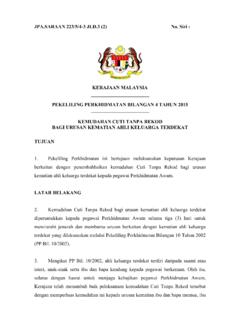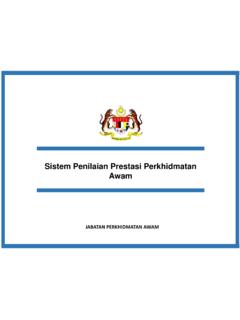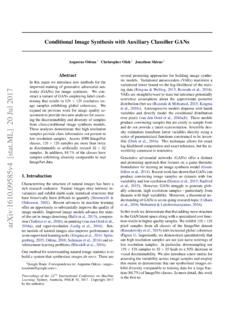Transcription of Introduction to WIFI - Jabatan Pendaftar
1 Introduction to WIFIC ontents Introduction Wi-FiTechnology Wi-FiNetworkElements Wi-FiNetworkTopologies Hotspots HowaWi-FiNetworkWorks Advantages Limitations ConclusionWIFI TechnologyWIFI is stand for Wireless Fidelity is generic term that refers to standard for Wireless Local Networks or connects computers to each other, to the internet and to the wired WIFI TechnologyWIFI uses radio technology to transmit and receive data at high speed. IEEE IEEE IEEE Appear in Late 1999 radio spectrum 11 Mbps (theoretical speed) within 30m range 4-6 Mbps (actual speed) 100-150 feet range Most popular and Less expansive Interference from mobile phones and Bluetooth devices which can reduce the transmission speedIEEE introduced in 2001 radio spectrum 54 Mbps (theoretical speed) 15-20 Mbps (actual speed) 50-75 feet range more expansive not compatible with IEEE introduced in 2003 combine the feature of both standards (a,b) 100-150 feet range 54 Mbps speed radio spectrum compatible with bElements of WIFI network AccessPoint(AP)
2 -TheAPisawirelessLANtransceiveror basestation thatcanconnectoneormanywirelessdevicessi multaneouslytotheInternet. of WIFI network Topologies Peer-to-peer topology (Ad-hoc Mode) AP-based topology (Infrastructure Mode)Peer-to-peer Topology AP is not required. Clientdeviceswithinacellcancommunicatewi theachotherdirectly. TopologyInfrastructure network The client communicate through Access Point. Any communication has to go through AP. If a Mobile Station (MS), like a computer, a PDA, or a phone, wants to communicate with another MS, it needs to send the information to AP first, then AP sends it to the destination networkHotspots AHotspotisageographicalareathathasareadi lyaccessiblewirelessnetwork HotspotsareequippedwithBroadbandInternet connectionandoneormoreAccesspointsthatal lowuserstoaccesstheinternetwirelesslyHot spots a Wi-Fi network Works AWi-Fihotspotiscreatedbyinstallinganacce sspointtoaninternetconnection.
3 Anaccesspointactsasabasestation. a Wi-Fi network Works Asingleaccesspointcansupportupto30usersa ndcanfunctionwithinarangeof100 150feetindoorsandupto300feetoutdoors. a Wi-Fi network WorksAdvantages Mobility Ease of Installation Flexibility Cost Reliability Security Use unlicensed part of the radio spectrum Roaming SpeedLimitations Interference Degradation in performance High power consumption Limited rangeConclusion Wi-Fiisasimpleandcosteffectivewaytoconne cttointernetwithouttheneedofwires. Itisgrowinginpopularitybecauseofdecreasi ngcostsandthefreedomitgivestousers.








